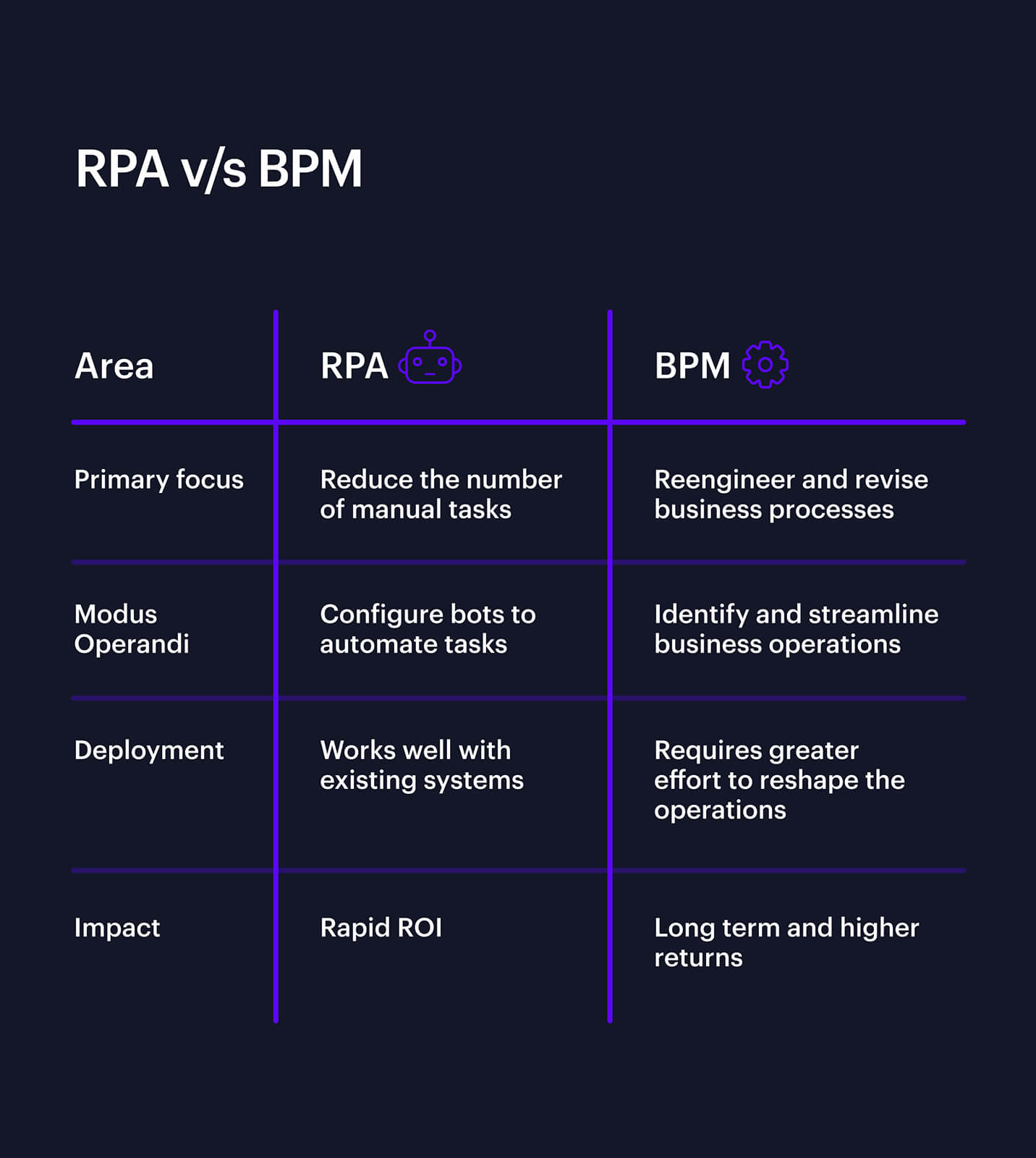
Robotic Process Automation (RPA) and Business Process Management (BPM) are two process-oriented initiatives that complement each other when it comes to planning, improving, streamlining, and automating the operations of an enterprise. While they are related, they are not the same. Sharing the same ancestry, RPA and BPM are cousins that streamline business operations and aim to keep customers happy. While BPM streamlines all business operations, RPA is ideal for automating mundane and repetitive tasks. How does a business benefit when you bring BPM and RPA together?
What is robotic process automation?
Robotic Process Automation (RPA) involves the use of software bots to automate individual human tasks and mimic their interactions with software systems. The goal of these RPA bots is to operate processes similar to how humans would by recording the procedure workflow while existing more on the surface level.
While traditional automation follows instructive code, RPA bots are trained with illustrative steps, allowing them to adapt to dynamic events. For example, when a customer misses a field while filling out a bank form, the RPA tools fill it out automatically whereas traditional automation requires human intervention. The RPA bots log onto the existing platform and do tasks like copying and pasting data, moving files, and mechanical jobs of lesser value that consume human effort and time.
Businesses of all scales are now adopting RPA to automate their operations. As a result, the market for RPA is ever-growing. With technologies like Artificial Intelligence (AI), Machine Learning (ML), and Big Data on the rise, RPA has gotten even more powerful. As a result, businesses that adopt this technology increase their productivity.
One of the biggest benefits of RPA is that it can cut costs without any expensive updates to the existing infrastructure and systems, as it emulates and replaces human actions using the current IT environment.
What is business process management?
Business Process Management or BPM (also called process management) is not just about managing individual tasks, it involves the whole process end-to-end. The core purpose of BPM is to help businesses make accurate and speedy decisions rather than just automate data entry.
BPM focuses more on streamlining and reengineering underlying business operations to drive the organization’s efficiency and productivity. BPM and its tools elevate the entire operations of an enterprise by analyzing how they work in different scenarios, making modifications to them, scrutinizing the revised procedures, and continuously optimizing them.
With ever-rising customer expectations, businesses are making it a priority to elevate their customer responsiveness and initiate collaboration, which they can achieve only by bringing technology and human effort together rather than letting them work in silos.
BPM does not necessarily include automation. While BPM is actually the method or technique of optimizing business processes, Business Process Management Autonation (BPMA) or Business Process Automation (BPA) is a subset of BPM that involves a collection of technologies used to execute the parent process.
RPA vs BPM: What are the key differences
The core purpose of both RPA and BPM is to execute business functions more efficiently through automation. But what’s the difference between RPA and BPM? Let’s check out an overview of robotic process automation vs business process management.

The primary focus of RPA bots is to reduce the number of manual, redundant, and rule-based tasks that do not require any complex decision-making. Meanwhile, BPM focuses on reengineering and revising business processes to enhance efficiency and productivity across the organization.
RPA configures bots to conduct monotonous and time-consuming tasks that help the business save time and free employees to focus on more complex and high-priority tasks. Meanwhile, BPM identifies and streamlines the operations of the organization, helping get rid of bottlenecks and obtaining shorter work cycles.
As RPA bots seamlessly integrate and work with the existing tools and processes of the organization, the deployment effort needed is minimal. On the other hand, BPM requires comparatively higher effort as it reshapes the entire business effort of the organization.
RPA offers rapid and immediate returns on investment. However, RPA bots might not always address the existing underlying inefficiencies in the business process. As BPM reshapes the business process, the impact it makes is high and long-term. It leads to an overall reduction in costs, greater efficiency, improved agility, enhanced productivity, and compliance.
When to use RPA and BPM
RPA is ideal for businesses that still run on critical systems, as replacing them is extremely expensive, and the only way to access them is via their user interface. Integrating with advanced APIs is out of the question. These businesses have a solid process, but the individual tasks can be repetitive and tedious. Here, RPA comes in handy as it’s a perfect option to automate the system without any significant disruption, given that the existing process is solid.
BPM is ideal when you need to improve the processes that need human intervention to execute them or require third-party integration. BPM is perfect when redesigning the entire process and embarking on a business’s journey to digital transformation.
When deployed together, RPA and BPM become a powerful combo that supports digital transformation across the organization. While a business can use BPM to re-engineer and automate its process, RPA is perfect to automate a few rule-based tasks.
Integrating RPA and BPM
Relatively new to the scene, RPA enhances BPM strategies to a new level and resolves new problems. While RPA automates tasks that computers perform, like data extraction and transfer, BPM manages processes that suffer from long-time mismanagement and oversight. With RPA and BPM working in sync, the results are for sure a game-changer for a business.
BPM redefines and improves legacy systems that are complex and outdated, executing critical business functions that otherwise require human intervention and oversight. RPA executes repetitive and mundane tasks while integrating easily into the complex system. The combination saves a great deal of time and effort, along with cutting down the errors and enriching data quality. Businesses of all industries now use RPA and BPM in tandem to smoothen all their operations and increase their efficiency.
The powerful combo of BPM and RPA gives businesses various benefits, including:
BPM is accelerated
One crucial advantage that RPA offers is that it speeds up the routine tasks of an organization which is generally time-consuming. RPA alleviates the otherwise congested job pipelines, in turn making the BPM mechanism more efficient and keeping it running smoothly. Adding the RPA mechanism to specific sections of the BPM process is similar to keeping a machine well-lubricated, enabling its seamless and efficient operation.
Restructures the workforce
Deploying RPA bots at the workplace has an extremely positive impact as the employees do not have to deal with tiring and mundane tasks. Freeing the workforce from these tasks also boosts their morale and helps the management and human resource deploy them on tasks that require imagination and lateral thinking. RPA lets you run a workforce efficiently.
Seamless integration
With BPM already up and running, integrating RPA will be a piece of cake without causing a disturbance to the current operations. RPA and BPM do not overlap with each other. Instead, they complement each other to boost efficiency.
Faster results
While BPM gives long-term results, it takes time for the yields to pour in. RPA, on the other hand, offers immediate results as soon as you create and deploy the bots. Who could say no to faster results in the system, giving businesses a competitive edge?
Versatile potential
Bots serve the purpose of executing duties across multiple verticals like administrative, customer-facing, onboarding jobs, or other tasks. With BPM consisting of a multitude of processes to cover the broad area of business operations, deploying RPA across multiple sectors improves the potential of BPM activities.
Eliminating bottlenecks
Swivel chair activities might cause data duplication as a result of logging entries from multiple systems. These activities create a clog in the otherwise smooth-running BPM process. RPA bots are perfect to carry out repeatable and time-eating tasks unclogging the data, and eliminating all the bottlenecks a BPM faces.
Optimizing APIs
Repeatedly optimizing Application Process Interfaces(APIs) for low-level BPM tasks can be painful. Deploying RPA bots to engage APIs increases the efficiency of BPM processes.
Still, have doubts about choosing between RPA and BPM? Let’s take your automation journey a step further.
Case Studies
Let our work do the talking
Learn about the instances where we were able to create an impact, raising the bar on the standards we set for ourselves.

PiServe — Revolutionizing the versatility of technology in the corporate world
Curated Technologies. Design at Heart. Rapid business Transformation
Insights
The information technology times
Have a read on groundbreaking figments of imagination of the brightest minds that have been brought to life.
How can we help you?
Get in touch and let’s find out how we can curate our offerings to match your organization’s needs.
Get in touchSign up for our latest insights.
Never miss an insight. We’ll email you when new articles are published.
Subscribe.
Thanks for subscribing to PiServe Insights.
Please fill in the details.










